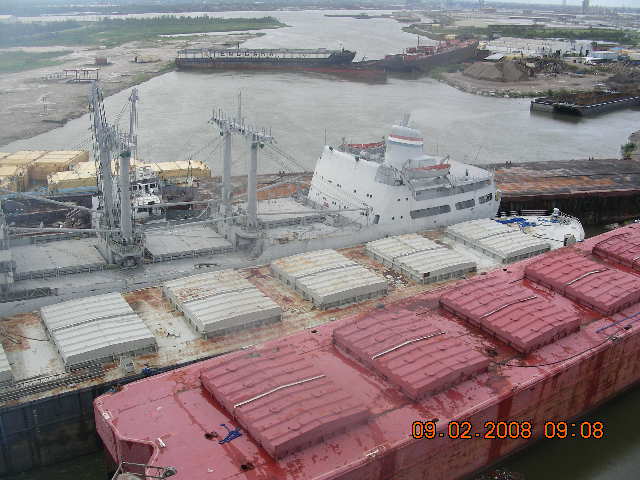Basic Statistics
Dates
Maximum wind speed Minimum pressure Deaths Damage Landfall
August 25- Septermber 4, 2008
250 km/hr (155 mph) 941 mb 112 6.6 Billion U.S. Haiti, Jamaica, Cuba, Louisiana Hurricane Gustav developed from a tropical wave that moved off the African coast on August 13, 2008. The system showed no signs of development as it crossed the Atlantic Ocean, and it wasn’t until 25 August that it became a tropical depression while located 153 km (95 mi) north of Bonaire. Twelve hours later, the system became Tropical Storm Gustav. It then intensified into a hurricane just twelve hours after that. Hurricane Gustav reached an intensity of 148 km/h (92 mph) on 26 August before its first landfall in Haiti. On 26 August, Gustav weakened to a Category 1 Hurricane with 121 km/h (75 mph) winds before making landfall near Jacmel, Haiti. Gustav’s interaction with Haiti’s mountainous terrain caused it to weaken to a tropical storm. The system further weakened as its forward motion slowed and it continued to interact with Haiti. On 28 August, however, the center of the storm began to reform and winds increased in speed to 111 km/h (69 mph). It remained at this intensity as it moved towards Jamaica, making landfall as a Category 1 hurricane on the island’s east coast later that day. The storm turned west-northwest after moving off Jamaica’s west coast early on 29 August, when it was again upgraded to hurricane status as it moved over the warm northwestern Caribbean Sea. The hurricane rapidly strengthened as it approached the Cayman Islands. Early on 30 August, Gustav had reached Category 3 intensity, and just three hours later, the hurricane strengthened to Category 4 status.
A peak intensity with 249 km/h (155 mph) winds was reached as the hurricane made landfall on Cuba’s mainland in the western province of Pinar Del Rio late on 30 August. Once again, interaction with the land caused the hurricane to weaken significantly. The diameter of the storm expanded as it moved over the Gulf of Mexico, and tropical storm force winds occurred as far as 322 km (200 mi) from the center of the hurricane. Hurricane Gustav steadily moved in a northwest direction over the Gulf until it made its final landfall near Cocodrie, Louisiana on 1 September as a Category 2 hurricane with winds of 169 km/h (105 mph). Coastal Louisiana experienced a 2.7-4 m (9-13 ft) storm surge with the highest waves along the Mississippi River Delta. Hurricane Gustav was downgraded to a tropical storm while located 32 km (20 mi) southwest of Alexandria, Louisiana, on 1 September and then to a tropical depression over northwestern Louisiana the next morning. The tropical depression lingered over southwestern Arkansas for a day until an approaching cold front caused it to move northeastward and become extratropical. The storm’s remnants were absorbed by another low-pressure system over the Great Lakes on 5 September. Hurricane Gustav caused a total of at least $6.61 billion (2008 USD) in damage and 153 lives were lost. In Haiti, 77 people were killed and 10,250 houses were damaged or destroyed by Gustav’s winds and the 254 mm+ (10 in+) of rain that fell. Though a tropical storm at landfall, Gustav caused an estimated $210 million (2008 USD) damage in Jamaica. Most heavily impacted was the country’s transportation infrastructure. Two bridges, including the Hope River Bridge that links Jamaica’s capital to eastern areas of the city, were destroyed. Damage in Cuba was also significant, amounting to amount to $2.1 billion (2008 USD). Cuban agriculture was greatly impacted with the destruction of 32,000 acres of crops, including 3,100 tons of grapefruit and 906 tons of tobacco, two important exports for the country. Widespread damage occurred in Louisiana, with 34 parishes being declared Federal disaster areas. Baton Rouge, LA, was especially hard hit as it lies just north of Cocodrie, where the storm made landfall with winds of 169 km/h (105 mph). Damage was so significant that the entire city was shut down for several days, and it took four months to finalize debris cleanup. The city of New Orleans received modest flooding and wind damage, but was largely spared. Larto Lake, Louisiana reported a rainfall total of 533 millimeters (21 inches), and moderate flooding occurred throughout the rest of the state as a result of Gustav's heavy rains. Hurricane Gustav also produced 41 tornadoes as it moved throughout the Gulf Coast region. Fast Facts:
|


